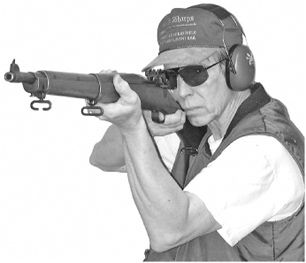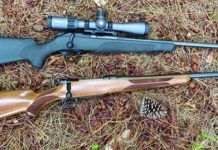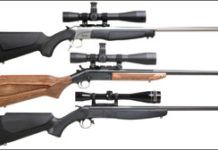
The U.S. fought WWI (and part of WWII) with bolt-action rifles. Among many different types and makes that saw active duty, the two that stand out were the 1903 Springfield and 1917 Enfield, both chambered in .30-06 caliber.
The history and makeup of these rifles is well discussed in numerous volumes, so we won’t go into detail here, but will tell you some of the most detailed information on the Springfield is given in Julian Hatcher’s Hatcher’s Notebook. He discusses the specific steel makeup, alloy variations, heat treatments, and modifications to the makeup of the rifles, and has serial-number references along the way. It is a fine source, though concise, but we’re sure there are other reference books available. Gen. Hatcher delves into the 1917 Enfield and its variants, too.
We acquired two rifles, a 1917 Enfield that might well have been in the trenches in the “Great War,” as WWI is sometimes called; and an 03A3 Springfield that probably saw action in WWII. The test rifles were both made by Remington. Both were chambered for .30-06, of course, and at first glance, we would have guessed that both had been through at least one trip to the armory. After serious inspection, we now believe the Enfield is all original. Our Remington-Springfield had a four-groove barrel, though Remington was the instigator of the two-groove barrel, and these were fitted to all 03A3s as they were made when new, according to Hatcher. So the barrel of our test Springfield was a replacement. We tried the rifles with mil-spec ammunition, with a modern hunting-type load, and with a mild handload featuring Speer’s 150-grain Hot-Cor spitzer bullets. As you’ll see, our testing was somewhat limited on one of the rifles. Here’s a detailed look at each of these two historic rifles.
[PDFCAP(1)]
The official designation of this rifle is, U.S. Rifle, cal. 30, M1903 A3. It’s easy to see why it’s called the Springfield 03A3, or just the 03A3 for simplicity’s sake. This rifle is, of course, a copy of the Mauser 98. Early Springfields, called the 03 model, had a milled trigger guard and barrel-mounted sights, but the A3 variant went to sheet-metal trigger guard, and numerous other changes that included an excellent rear aperture sight. The front blade sight, totally unprotected, was available in five different heights to regulate the rifle properly to the rear sight with the standard ammo in usage.
Our rifle looked pretty good for an old bird, the wood and metal both being exceptionally clean. The wood could have stood some linseed oil, but the metal finish looked very good everywhere, and retained most of the finish. The bands around the stock looked nearly new, their edges generally being subject to early wear. And the buttplate also looked like it had never sat all night in the mud anywhere. The stock on the 03A3 had a long forend cover of wood, extending rearward over the area where the 03 version had its rear sight. There were a few minor dents all along the stock, if you looked for them, but there was one main flaw, a crack running along the top of the wrist from the rear action tang backwards. The owner of the rifle provided a replacement stock, but we chose to test with the one that came with it. Our subsequent shooting tests proved the crack to be immaterial.
The action, as noted, was a copy of the M98 Mauser. In the case of this WWII-made Remington, the action and bolt steels were a later development by Remington that eliminated the “sticky” feel to the bolt. The very first of the Springfield rifles, with either single- or double-heat treating, were marked by exceptionally slick bolt operation. Some of the later nickel-steel actions and bolts had a sticky feel by comparison. The Remington-made rifle we tested was quite slick in its operation. The Springfield action had a three-position bolt release. Up was normal, middle was to remove the bolt, and down was the magazine cutoff position, which in the field permitted loading individual rounds easily while retaining the five rounds in the magazine in reserve. The rifle loaded either by stripper clips or by shoving rounds individually into the staggered-box magazine.
The safety was, like Mauser’s, a leaf or wing on the rear of the bolt that could be turned to the right for Safe, or left to Fire. In practice, the safety can be kept vertical, which permits very fast operation to release it and get the gun into action quickly. The right thumb sweeps the safety wing to the left as the gun is brought to the shoulder. This works very well for sporting rifles also. We’d love to see this on non-scoped rifles today, but to our knowledge no one makes any action with this excellent type of safety on it. Springfields also had a knob on the end of the bolt to permit recocking if a round didn’t fire. We wonder if anyone ever used this feature in the whole history of the rifle. Who would prefer to try a bad round again, instead of the obvious choice of working the bolt to get a fresh one?
The action was secured within the stock by two screws, both of which were extremely loose on our test rifle. In addition, two bands encircled the wood, and the barrel passed through a collar near the muzzle, which helped hold things together, and was also the bayonet mount. There were two sling swivels, plus a forward hook that looked like a slotted swivel, but was designed for stacking, to produce that archaic tree of rifles often seen in photos of Army camps dating to the Civil War, or even before. The huge, wide, comfortable steel buttplate had a trap door for a cleaning rod, which was missing.
The rear sight was a well-protected aperture that slid up and down a ramp, with markings running from 2 to 8, for 200 to 800 yards. There were no detents for elevation except for a spring-steel drag and vague clicks. Windage was by a knob on the right side of the sight. Its click-stops also felt vague and in need of either cleaning, or sharpening with a suitable tool to make them more positive. The entire rear sight was actually an add-on, securely fastened to the top of the rear action ring. The front sight was an unprotected blade pinned into a slot in its barrel-band-type base. We wondered at the fragility of that thin front blade. The blade was soft, and presumably would be bent before it snapped off. The sight picture was excellent, though some of us would have liked a thicker front blade. Our test rifle’s front sight was worn to a rounded configuration, as seen by the shooter. After a few shots at the range showed serious vertical stringing, we flattened the top with a file and blackened it for our tests, with amazing results, as you’ll see.
The trigger pull was two-stage, requiring about 2 pounds for the first stage, and breaking at 3.4 pounds total weight. The trigger was extremely controllable. Cocking was sure and simple, and the Springfield cocked on lifting the bolt. (The Enfield cocked on closing, as did the British 1914 Enfield, which inspired the 1917, and this was thought to be faster in action.) All the operations of the bolt and rifle were slick and clean, and the rifle generally showed excellent workmanship. We saw some roughness on the exterior barrel turning, but as noted the four-groove barrel was a replacement. It was the only metal on the rifle that showed coarse machining.
[PDFCAP(2)], we anticipated getting hurt by the steel recoil plate on the test bench, shooting the 03A3 over our machine rest. However, that didn’t happen because of the large surface area of the buttplate. The rifle’s weight also helped cut the kick, but in all our shooting — some of it with hot factory fodder — we never got so much as stung. Our face got hit a few times by our thumb, the stock having a short (mil-spec) pull, but felt recoil was essentially nil. Our first two 100-yard groups showed lots of vertical stringing. They measured close to 3 inches on average. As noted above, we didn’t like the look of the top of the front sight, filed it flat, and resumed shooting. Our next group with the military ammo was just 1.0 inch.Subsequent shooting told us this was trying to be a match rifle, despite its rough-looking barrel. In fact, before we shot the Springfield we wondered if we’d be able to hit the target. We scrubbed the bore, but it still wasn’t pretty when we took it to the range. Yet the rifle shot like a house-afire. No, we can’t explain it.
With the rear sight at its lowest setting, and after filing the front sight, our shots landed about 3 inches above point of aim at 100 yards. That would put them close to dead nuts at 200, for which the rifle is generally sighted. So our filing had improved things immensely. We love it when a plan comes together. We noted that feeding of this rifle was so slick, particularly for the last two rounds in the magazine, that we were sure the bolt had missed the cartridge on the way forward. But the rifle never failed. It was a fine experience to feel this operation, feeding of a bolt rifle like most folks have only dreamed about. No modern rifle in our experience comes close to that slick feel. It’s no wonder these were made into custom rifles, though generally a milled trigger guard is used. Griffin & Howe made many, and Townsend Whelen carried one many years. Elmer Keith also liked the Springfield as a target rifle.
[PDFCAP(3)]
There were more than 2 million Enfields made before the end of WWI, most during 1918. There were but 300,000-odd Springfields made by war’s end, though many more were made during WWII. No Enfields were made for WWII. So the Enfield, with its cock-on-closing bolt, was the most prolific, if not the most popular, rifle in U.S. hands during WWI. The Enfield was a lot heavier than the Springfield. Any GI who packed one of these instead of the handy Springfield would end up with stronger arms and legs from toting the extra weight around. Our test sample showed excellent machining everywhere. The rifle was made late in the war, and despite the fact that a war was on, this rifle was made with great care. The serial number indicates it was one of the last to leave the Ilion, New York, plant. The barrel, which we believe is original, shows 9-18 as a date stamp, with the single letter R above an ordnance “bomb,” all of which indicates Remington made it in September 1918. The metal shows almost no machining marks anywhere on its surface, though rough turning marks are commonly seen on war-production barrels. There were some areas of rust here and there, and the magazine box cover and trigger guard had a nice, brown patina of age, as did most of the rest of the metal. Some of the metal appeared to have been rusted and then cleaned along the way, leaving areas of questionable finish.
The stock was clean and relatively ding-free, and not as dry as our Springfield’s stock. It could have been a replacement, but probably not as the barrel was not replaced. Again we found two sling swivels and a front stacking ring. The buttplate had an empty trap for cleaning rod. The Enfield’s sights bear strong mention. A distinct improvement, at the time of WWI, over those on the Springfield, they consist of a strongly protected aperture rear, with a ladder that permitted aimed cluster fire out to 1,600 yards, a tactic that was apparently commonly used in WWI. The front blade was thick, easily seen, and again well protected by two massive ears.
The action had some rust within the bolt, so using the usual penny to take it apart, we cleaned it briefly. Then after giving the bore a good scrubbing, it was off to the range. Our first shot from the bench hit nothing, so — as we had done with the Springfield for its first shot — we walked up to 25 yards and touched off another round from kneeling. It hit close to center. Back at 100 we fired some more, but of six shots, only one hit the paper. We closed in to 25 yards again and tried three shots with the Winchester hunting load, and got a group that measured well over 10 inches, the shots being all over the paper. This rifle had proved to be as bad as its bore looked. We halted all shooting with the Enfield at that time, realizing its old original barrel was useless for any realistic purpose. We noticed another problem with it, one that was flagged as being a common one by Julian Hatcher in his book. Ejection was non-existent. The little spring attached to the bolt release had apparently broken and would need to be replaced.
Gun Tests Recommends
With surplus rifles there are generally no guarantees. The rifle you get might not shoot well at all, or may have a bad trigger, or what have you. So buy with care, as always with used guns.
• Springfield 03A3, $450. Our Pick. This rifle was a real winner, we thought. It combined excellent accuracy with a sense of history that few other rifles have. We don’t know if the rifle would be good enough for a top shooter at Camp Perry, but would give most people all the accuracy they could hold for, given good ammunition.
• Enfield 1917, about $350. Conditional Buy. We thought it was a pity this otherwise good-looking old rifle didn’t shoot. We’re sure replacement barrels can be obtained, but it would be up the owner to decide if rebarreling to get a shootable gun would be worth the loss of collector value by removing what we believe to be the original barrel. We would not replace it. It’s rare to find an all-original rifle that hasn’t had its parts swapped out.




























i have a 30-06 British Enfield. It was my grandfather’s. I still hunt with it. My grandfather was an Electrician by day and a gunsmith at night. When I was in Kindergarten I remember him working on the gun. He sportorized the gun and it is a piece of art. I get nervous every time I take it out that I don’t drop it or bang it against something. The gun can shoot a 3″ group at over 500 yds. He bought the gun Army surplus sale back in the 1950s. He spent the better part of a decade sportorizing the gun. It still has the old Leopold 3×9 scope on it from the late 1950s/early 60s.